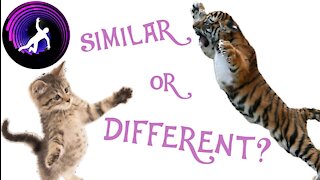Premium Only Content

Genus Panthera || The big cats genus! 3,5
Panthera is a genus within the family Felidae that was named and described by Lorenz Oken in 1816 who placed all the spotted cats in this group. Reginald Innes Pocock revised the classification of this genus in 1916 as comprising the species tiger (P. tigris), lion (P. leo), jaguar (P. onca), and leopard (P. pardus) on the basis of common cranial features. Results of genetic analysis indicate that the snow leopard (formerly Uncia uncia) also belongs to the Panthera (P. uncia), a classification that was accepted by IUCN Red List assessors in 2008.
The tiger, lion, leopard, and jaguar are the only cat species with the anatomical structure that enables them to roar. The primary reason for this was formerly assumed to be the incomplete ossification of the hyoid bone. However, new studies show the ability to roar is due to other morphological features, especially of the larynx. The snow leopard does not roar. Although its hyoid bone is incompletely ossified, it lacks the special morphology of the larynx.
In Panthera species, the dorsal profile of the skull is flattish or evenly convex. The frontal interorbital area is not noticeably elevated, and the area behind the elevation is less steeply sloped. The basicranial axis is nearly horizontal. The inner chamber of the bullae is large, the outer small. The partition between them is close to the external auditory meatus. The convexly rounded chin is sloping. All Panthera species have an incompletely ossified hyoid bone. Specially adapted larynx with proportionally larger vocal folds are covered in a large fibro-elastic pad. These characteristics enable all Panthera species except snow leopard to roar. Panthera species can prusten, which is a short, soft, snorting sound; it is used during contact between friendly individuals. The roar is an especially loud call with a distinctive pattern that depends on the species.
-
 4:56
4:56
The TJ Martino Podcast
4 years agoBig Cats vs. Small Cats
13 -
 48:12
48:12
BonginoReport
3 hours agoTX AG Paxton Joins Hayley, Has Sights Set on Senate Seat - Nightly Scroll w/Hayley Caronia (Ep.29)
36.6K29 -
 37:56
37:56
Michael Franzese
2 hours agoThe Man Who Invented the Mafia: Lucky Luciano
13.9K4 -
 LIVE
LIVE
Rebel News
9 hours ago $3.42 earnedLIVE: Rebels react as leaders face off in Day 2 English debate
2,294 watching -
 14:49
14:49
BEK TV
21 hours agoEP 7 - DUNSEITH DECLASSIFIED: ALLEGED ATTEMPTED MURDER VICTIM ADDRESSES “LOVE TRIANGLE” RUMOR
2.07K -
 LIVE
LIVE
LIVE WITH CHRIS'WORLD
2 hours agoLIVE WITH CHRIS'WORLD - AGAIN ON A THURSDAY?! LETS GO!
64 watching -
 LIVE
LIVE
VOPUSARADIO
3 days agoPOLITI-SHOCK! "Exposing Election Theft & Money Laundering"
36 watching -
 LIVE
LIVE
Badlands Media
17 hours agoQuite Frankly Ep. 3: The Gilded Age, Cabbage Patch Kids, Sleep Walking, More ft. Cultivate Elevate 4/17/25
1,124 watching -
 54:41
54:41
LFA TV
8 hours agoKilmar Abrego Garcia: Democrat Poster Child and MS-13 Terrorist | TRUMPET DAILY 4.17.25 7PM
5.04K2 -
 LIVE
LIVE
Mally_Mouse
4 hours agoLet's Hang!! - New Goals + Dressin Up!
130 watching